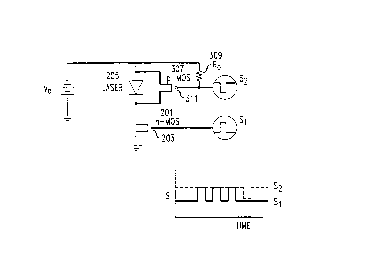Some of the information on this Web page has been provided by external sources. The Government of Canada is not responsible for the accuracy, reliability or currency of the information supplied by external sources. Users wishing to rely upon this information should consult directly with the source of the information. Content provided by external sources is not subject to official languages, privacy and accessibility requirements.
Any discrepancies in the text and image of the Claims and Abstract are due to differing posting times. Text of the Claims and Abstract are posted:
| (12) Patent Application: | (11) CA 2237506 |
|---|---|
| (54) English Title: | HIGH SPEED NON-BIASED SEMICONDUCTOR LASER DIODE DRIVER FOR HIGH SPEED DIGITAL COMMUNICATION |
| (54) French Title: | DISPOSITIF D'ATTAQUE DE DIODE LASER RAPIDE NON POLARISEE POUR LES COMMUNICATIONS NUMERIQUES RAPIDES |
| Status: | Deemed Abandoned and Beyond the Period of Reinstatement - Pending Response to Notice of Disregarded Communication |
| (51) International Patent Classification (IPC): |
|
|---|---|
| (72) Inventors : |
|
| (73) Owners : |
|
| (71) Applicants : |
|
| (74) Agent: | KIRBY EADES GALE BAKER |
| (74) Associate agent: | |
| (45) Issued: | |
| (22) Filed Date: | 1998-05-13 |
| (41) Open to Public Inspection: | 1998-12-18 |
| Examination requested: | 1998-05-13 |
| Availability of licence: | N/A |
| Dedicated to the Public: | N/A |
| (25) Language of filing: | English |
| Patent Cooperation Treaty (PCT): | No |
|---|
| (30) Application Priority Data: | ||||||
|---|---|---|---|---|---|---|
|
The length of the tail which results in an optical output from a laser diode after the
laser diode is no longer being driven is reduced or eliminated by a laser diode driver with
a tail eliminator. More specifically, the laser diode driver includes an energy drainage
path that is activated when packet communication is over. In one embodiment of
invention, the terminals of the laser diode are short-circuited to provide the energy
drainage path. In another embodiment of the invention, the laser diode is reverse biased,
so that charges stored in the laser diode are combined with charges which are provided
thereto. Advantageously, the tail emission is substantially eliminated.
La durée de la lumière résiduelle émise par une diode laser après l'interruption de l'alimentation de cette dernière est réduite ou annulée à l'aide d'un dispositif d'attaque doté d'un éliminateur de lumière résiduelle. Plus exactement, ce dispositif d'attaque comprend un trajet de drainage d'énergie qui entre en fonction quand la transmission d'un paquet est terminée. Dans l'une des concrétisations de l'invention, les bornes de la diode laser sont court-circuitées pour créer le trajet de drainage d'énergie. Dans une autre concrétisation, la diode laser est polarisée en inverse et les charges qui y sont stockées sont combinées avec d'autres charges qui lui sont fournies. Il en résulte une réduction importante de la lumière résiduelle.
Note: Claims are shown in the official language in which they were submitted.
Note: Descriptions are shown in the official language in which they were submitted.

2024-08-01:As part of the Next Generation Patents (NGP) transition, the Canadian Patents Database (CPD) now contains a more detailed Event History, which replicates the Event Log of our new back-office solution.
Please note that "Inactive:" events refers to events no longer in use in our new back-office solution.
For a clearer understanding of the status of the application/patent presented on this page, the site Disclaimer , as well as the definitions for Patent , Event History , Maintenance Fee and Payment History should be consulted.
| Description | Date |
|---|---|
| Inactive: IPC expired | 2013-01-01 |
| Inactive: IPC deactivated | 2011-07-29 |
| Inactive: First IPC derived | 2006-03-12 |
| Inactive: IPC from MCD | 2006-03-12 |
| Inactive: IPC from MCD | 2006-03-12 |
| Inactive: Dead - No reply to s.30(2) Rules requisition | 2002-08-26 |
| Application Not Reinstated by Deadline | 2002-08-26 |
| Deemed Abandoned - Failure to Respond to Maintenance Fee Notice | 2002-05-13 |
| Inactive: Abandoned - No reply to s.30(2) Rules requisition | 2001-08-27 |
| Inactive: S.30(2) Rules - Examiner requisition | 2001-02-26 |
| Application Published (Open to Public Inspection) | 1998-12-18 |
| Inactive: IPC assigned | 1998-08-11 |
| Classification Modified | 1998-08-10 |
| Inactive: First IPC assigned | 1998-08-10 |
| Inactive: IPC assigned | 1998-08-10 |
| Application Received - Regular National | 1998-07-24 |
| Inactive: Filing certificate - RFE (English) | 1998-07-24 |
| Request for Examination Requirements Determined Compliant | 1998-05-13 |
| All Requirements for Examination Determined Compliant | 1998-05-13 |
| Abandonment Date | Reason | Reinstatement Date |
|---|---|---|
| 2002-05-13 |
The last payment was received on 2001-03-23
Note : If the full payment has not been received on or before the date indicated, a further fee may be required which may be one of the following
Patent fees are adjusted on the 1st of January every year. The amounts above are the current amounts if received by December 31 of the current year.
Please refer to the CIPO
Patent Fees
web page to see all current fee amounts.
| Fee Type | Anniversary Year | Due Date | Paid Date |
|---|---|---|---|
| Application fee - standard | 1998-05-13 | ||
| Registration of a document | 1998-05-13 | ||
| Request for examination - standard | 1998-05-13 | ||
| MF (application, 2nd anniv.) - standard | 02 | 2000-05-15 | 2000-03-29 |
| MF (application, 3rd anniv.) - standard | 03 | 2001-05-14 | 2001-03-23 |
Note: Records showing the ownership history in alphabetical order.
| Current Owners on Record |
|---|
| LUCENT TECHNOLOGIES INC. |
| Past Owners on Record |
|---|
| YUSUKE OTA |